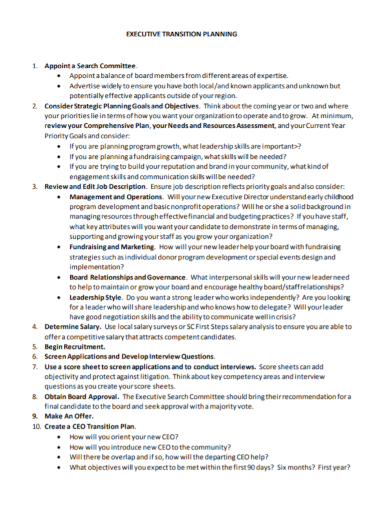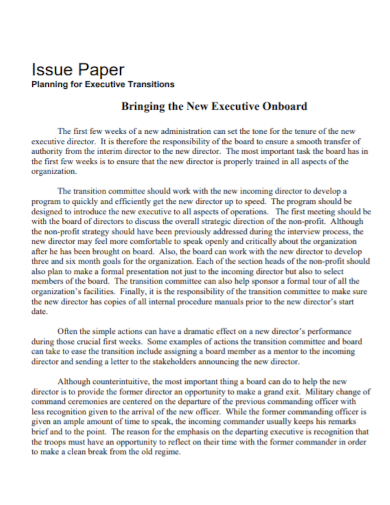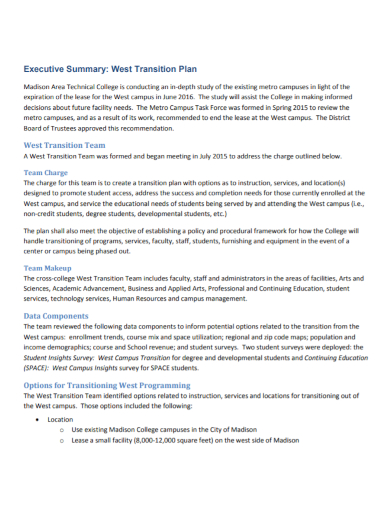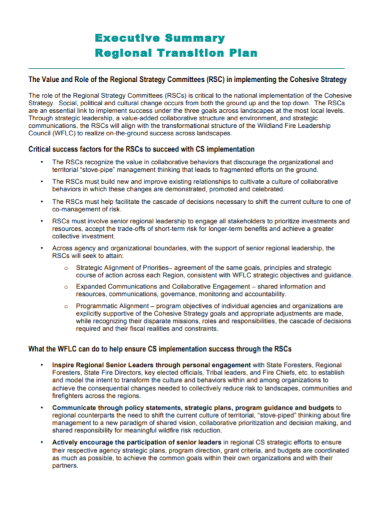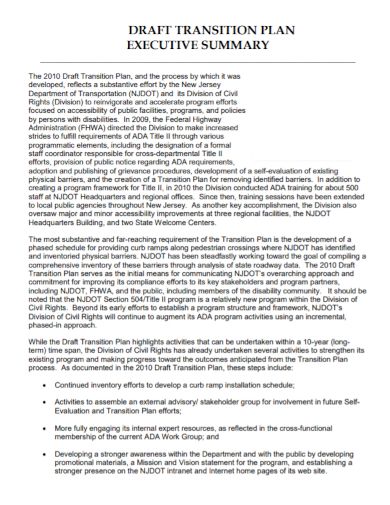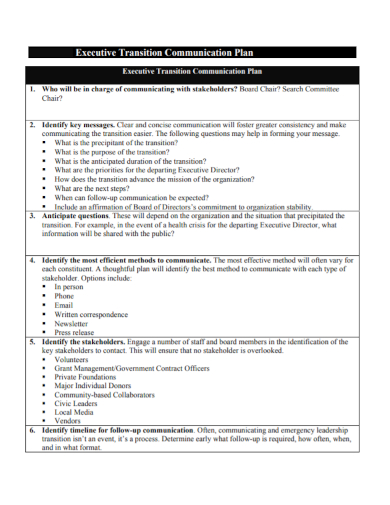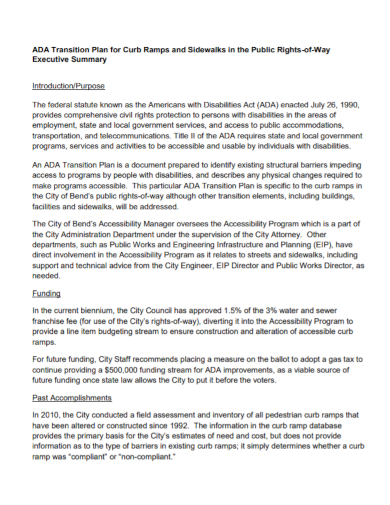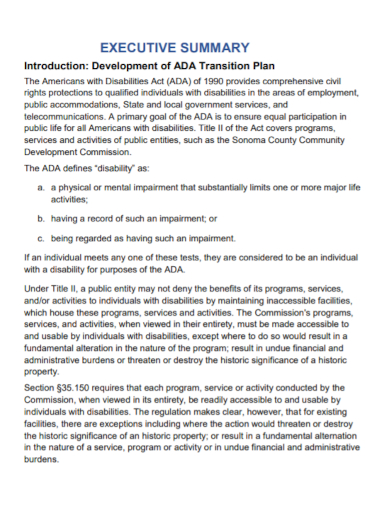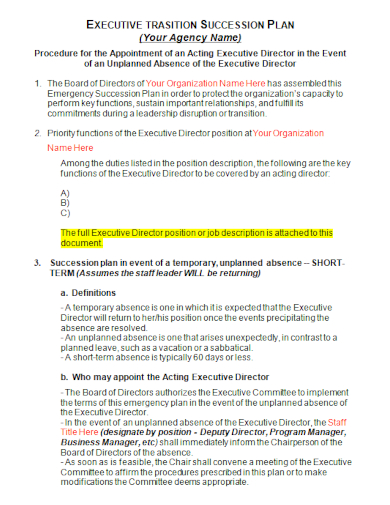A part of working in a business organization is to experience a shuffling of executive roles. It is an inevitable event since top executives aren’t exempted from stepping up further up the corporate ladder or if they decided to separate from the company for good. To further finalize this process, an executive transition plan is established. This is in order to ensure that the transition and succession process from one executive to another runs smoothly. Take a look at exactly how to develop a successful transition plan by checking out our free executive transition plan samples below.
8+ Executive Transition Plan Samples
1. Executive Transition Plan
2. Plan for Executive Transition
3. Executive Summary Transition Plan
4. Executive Summary Regional Transition Plan
5. Transition Plan Executive Summary
6. Executive Transition Communication Plan
7. Transition Plan Public Executive Summary
8. Executive Development Transition Plan
9. Executive Transition Succession Plan
What Is an Executive Transition Plan?
An executive transition or leadership transition plan is a written document that is developed by top management ensure continued operations and a smooth transition in the event of a planned or unplanned extended absence or departure of a company executive. These plans are carefully devised so that the new leadership could easily adapt to the role, responsibilities and the work intended for him or her. Onboarding plans and programs are part of the transition process to help the new leader understand and have a clear sense of how to manage the organization or department.
How to Establish an Executive Transition Plan?
The succession process like any other needs to undergo a variety of procedures, careful planning and organizing to make sure nothing goes amiss. More so if this role belongs to a top executive, as how they choose to run a company or department would define the outcome, so this is a critical moment that comes with risk. So it is imperative that they are aware and fully prepared on the task and responsibility set up for them. Planning requires that the organization identify the various types of vacancies or departures and create sub-plans. This will enable the organization to ensure all essential tasks have a back up plan in the event of a short term or long term absence. To further understand how an executive transition plan works, here are some key factors to go through:
I. Purpose and Introduction
Every leadership transition always has to have purpose on why the transition process is taking place in the first place. Include an introduction of the company and clearly describe the reason of the leadership change and its impact to the company or department.
II. Planning and Summary of Roles
Identifying the critical positions within the organization and their key leadership and management functions. Outlining to whom various leadership and management functions will be delegated.
III. Set Expectation Deadline
Draft a timeline for leadership successions that are planned. Normally this would take a 3 months to almost a year for executives to create an impact to the company. Their task would either create new business partnership or innovation or re-organize programs that deem fit for the organization.
IV. Understand the Risk
Executive transition is always exposed to risk. If you are used to the previous leader and how he or she ran things, whether negatively or in a positive way, adapting a new in-coming leader will leave employees and management hoping for a better outcome. So, it is part of the whole transition process to always include a risk assessment process to give you an idea of what lies ahead can help you to be prepared.
V. Creating an Onboarding Program
Implementing mechanics that assess readiness to assume leadership positions and for providing training, mentorship, and other leadership development opportunities to support readiness. But on boarding should not only be limited with the basics and necessary paper works, executives must also be socializing meaning learning about the work culture, relationship building, and building the executive’s content knowledge. Ultimately, the goal is to set your leader up for long-term success.
FAQs
What Is an Organizational Change?
This is a movement whereas companies or organizations changes its working methods or aims such as its culture, the underlying technologies or infrastructure it uses to operate, or its internal processes.
What Is a Transition Coaching?
This is a method where a transition coach helps client learn to cope with challenging transitions in their lives. This procedure would promote a sense of fulfilment and transformation.
What Is a Non-profit Organization?
A non-profit organizations are institutions that that conduct their affairs for the purpose of assisting other individuals, groups, or causes rather than garnering profits for themselves.
Establishing an effective executive transition plan relies on right execution process. Ultimately, what is at stake is the organization’s future, the well-being of its staff, its credibility, legitimacy and identity as an organization, and how it is perceived internally and externally and therefore its financial status and stability. Each of these will be conditioned by both the transition process and the profile and actions of the new director. If these are in sync, then the new executive would be able to perform his or her task well for the benefit of the entire organization.
Related Posts
FREE 8+ Debt Management Plan Samples in PDF | DOC
FREE 10+ Sales Management Plan Samples in PDF | MS Word | Apple Pages | Google Docs
FREE 4+ 30-60-90-Day Marketing Plan Samples in MS Word | Google Docs | Apple Pages | PDF
FREE 10+ Higher Education Lesson Plan Samples in MS Word | Pages | Google Docs | PDF
FREE 9+ 30-Day Marketing Plan Samples in PDF | MS Word | Apple Pages | Google Docs
FREE 3+ Sales Team Action Plan Samples in PDF | MS Word | Apple Pages | Google Docs
Marketing Plan For Small Business Samples
FREE 7+ Fashion Business Plan Samples in PDF
FREE 10+ Sprint Planning Samples In MS Word | Google Docs | PDF
FREE 10+ Wedding Planning Samples in MS Word | Apple Pages | Powerpoint | PDF
FREE 9+ Monthly Study Planner Samples in PSD | Illustrator | InDesign | PDF
FREE 9+ Sample Curriculum Planning Templates in PDF | MS Word
FREE 10+ Teacher Development Plan Samples in MS Word | Google Docs | Apple Pages | PDF
FREE 10+ Basketball Practice Plan Samples in PDF
FREE 12+ School Business Plan Samples in PDF | MS Word | Apple Pages | Google Docs

